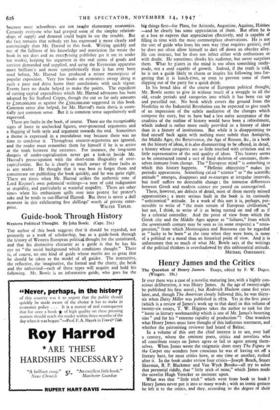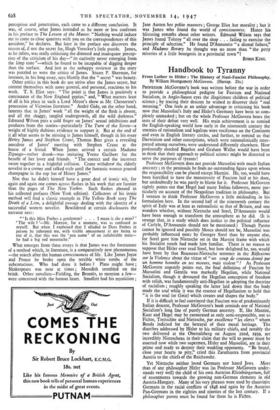Henry James and the Critics - IF ever there was
a case of a novelist maturing late, with a highly con- sciouS deliberation, it was Henry James. At the age of twentyreight he published his first novel ; but Roderick Hudson came five years later, and, though The American closely followed this, he was thirty- six when Daisy Miller was published in 1879. Yet in the first piece (which is a review of James's work up to that date) in this volume of twenty-six essays, T. W. Higgens takes the author to task for the " haste in literary workmanship which is one of Mr. James's besetting sins " and for his " extreme rapidity of production "! One wonders what Henry James must have thought of this ludicrous statement, and whether the patronising reviewer had heard of Balzac.
In a volume of this sort the chief interest is to see, over half a century, where the eminent poets, critics and novelists who all contribute essays on James agree or fail to agree among them- selves. When James wrote the enigmatic short story The Figure in the Carpet one wonders how conscious he was of having set off a, literary hare, for most critics have, at one time or another, rushed after it. In the book under review four critics—Joseph Beach, Stuart Sherman, R. P. Blackmur and Van Wyck Brooks—all try to solve that perennial riddle, that " little trick of mine," which James made the novelist Hugh Verecker so insistent upon.
What was that " little trick " which went from book to book ? Henry James never put it into so many words ; with an ironic gesture he left it to the critics, and they, according to the degree of their
perception and penetration, each came to a different conclusion. It was, of course, what James intended as he more or less confesses in his preface to The Lesson of the Master. "Nothing would induce me to come to close quarters with you on the correspondences of this anecdote," he declares. But later in the preface one discovers the reason of, if not the secret for, Hugh Verecker's little puzzle. James, as he infers, was really criticising the dimmed and inadequate percep- tion of the criticism of his day—" its curiosity never emerging from the limp state "—which he found to be incapable of digging deeper than the surface. And just as the unhappy reviewer in the story was puzzled so were the critics of James. Stuart P. Sherman, for instance, in his long essay, says bluntly that the " secret" was beauty..
Other critics in this book do not strive after the James secret, but content themselves with more general, and personal, reactions to his work. T. S. Eliot says : " The point is that James is positively a continuator of the New England genius," and, " What matters least of all is his place in such a Lord Mayor's show as Mr. Chesterton's procession of Victorian literature." Andre Gide, on the other hand, laments that in James' work " all the weight of the flesh is absent, and all the shaggy, tangled undergrowth, all the wild darkness." Edmund Wilson puts a cold finger on James' sexual inhibitions and produces from the stories—particularly The Turn of the Screw—a weight of highly dubious evidence to support it. But at the end of it all what seems to be missing is James himself, though in his essay Henry James and Stephen Crane, Thomas Beer gives a revealing anecdote of James' meeting with Stephen Crane at the house of a friend. When James arrived a certain Madame Zipango—rather drunk—was imitating Yvette Guilbert for the benefit of her lover and friends. " The correct and the incorrect swam together in a frightful collision. Crane withdrew' the elderly novelist to a corner and talked style until the fantastic woman poured champagne in the top hat of Henry James."
Not that he didn't himself have a great deal of ironic wit, for again and again one comes across flashes in his work that are funnier than the pages of The New Yorker. Such flashes abound in his collected prefaces (New York edition). Collectors of his ironic method will find a classic example in The Yellow Book story The Death of a Lion, a delightful passage dealing with the identity of a successful women novelist. Bewildered at certain disclosures the narrator says : " Is this Miss Forbes a gentleman? . . I mean is she a man? ' ' The wife ? '—Mr. Morrow, for a moment, was as confused as myself. But when I explained that I alluded to Dora Forbes in person he informed me, with visible amusement at my being so out of it, that this was the ' pen name ' of an indubitable male— he had a big red moustache."
What emerges from these essays is that James was the forerunner of a method which, in literature, is a comparatively new phenomenon —the search after the human consciousness of life. Like James Joyce and Proust he broke open the terrible white tombs of the subconscious. Who had done it before ? Plato might have ; Shakespeare was near at times ; Meredith trembled on the brink. Other novelists—Fielding, the Brontes, to mention a few— were concerned with the human heart. Smollett had his mysticism ; Jane Austen her polite manners ; George Eliot her morality ; but it was James who found the world of consciousness. Hence his blistering remarks about other writers. Edmund Wilson says that James found Tolstoy " all over the shop . . . failing to exercise the principle of selection." He found D'Annunzio " a dismal failure," and Madame Bovary he thought was no more than " the petty miseries of a little bourgeois in a provincial town"!
ROBIN KING.































 Previous page
Previous page